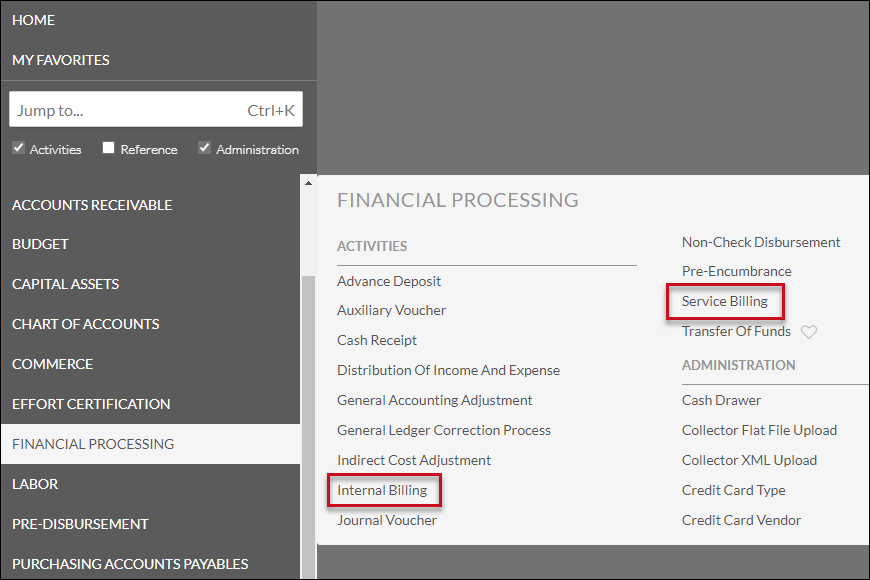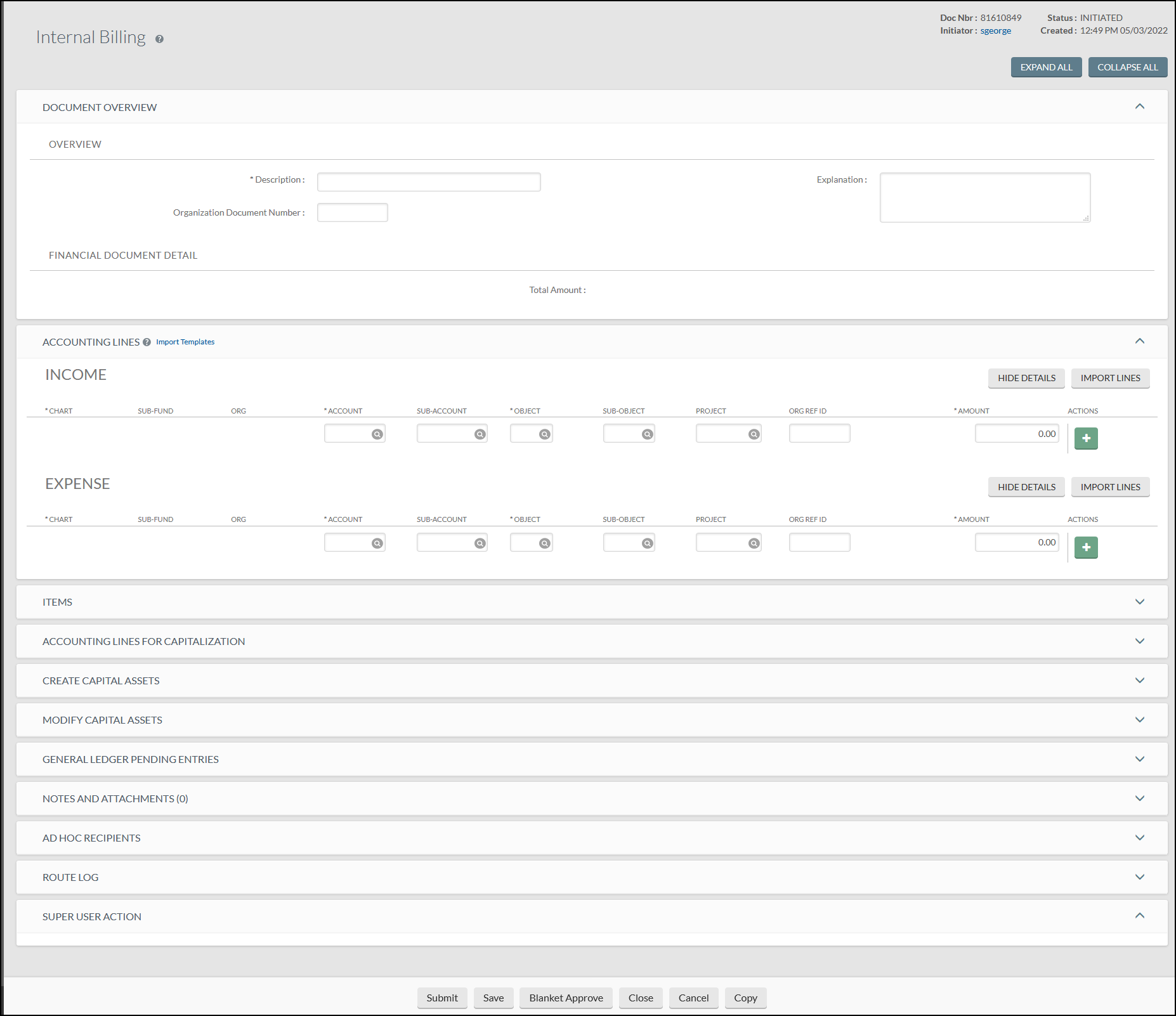Prerequisites
Prior to reading the standard on Internal and Service Billing documents, it is beneficial to review the below sections to gain foundational information:
- Accounting Fundamentals Section
- Chart of Accounts and General Ledger Section
- Financial Statements Section
- Revenue Producing Activities - Reporting Requirements Section
- Requirements for Recharge Accounts
Preface
This standard discusses the elements of Internal Billing as well the KFS Internal Billing (IB) and Service Billing (SB) documents and how they are used within Indiana University. Information presented below will walk through a general understanding of the documents, and will specify requirements and best practices.
Introduction
Internal billing is a billing for goods or services between two IU units. The IB and SB documents are used to record the income and corresponding expense for any billings of goods or services between university accounts that exceed annual revenues greater than $100,000. Internal Billing documents are used by units that have minimal billings to other units, the IB will route for approval to fiscal officers of accounts being billed. The Service Billing document is also used to bill internal units, however the SB is limited to use by units with large volume billing and does not route for approval. Internal billing activities under $100,000 in annual revenues are required to use other KFS document types (see Requirements for Recharge Accounts). The department providing the good or service will record income and a corresponding expense for the receiving department. These transactions are also referred to as interdepartmental sales and purchases.
Importance and Impact of the Internal and Service Billing Documents
The timely and proper recording of income and expense transactions between internal accounts is important to ensure that university financial records are accurate, timely budgetary planning, and recovery of all reimbursable expenditures from external sponsoring organizations (e.g. contract and grant accounts).
Incorrect usage of Internal or Service Billings can lead to compliance issues. For example, sponsored accounts require billings be completed within a stated period of time and to meet specific requirements of the sponsor.
Internal Billings and Service Billings
The Kuali Financial System (KFS) has several documents available for users to record transactions between university accounts. The IB and SB documents are used ONLY to bill for internal transactions where one university department is providing a good or service to another university department for a fee. Each document has a specific purpose and has embedded chart of account (i.e., fund group, account, and object code) restrictions to help ensure the document is used properly.
The IB document should be used by approved recharge accounts that have a small to moderate volume of transactions. The IB routes for approval to the fiscal officer of each account listed on the expense side of the document.
The use of the SB document is limited to departments that have frequent mass billings for which the IB cannot be used. The SB is a restricted use document and does not route for approval.
Note: Access to the SB document requires pre-approval by the Office of the University Controller (UCO). In order to gain access to the SB document, an organization fiscal officer should complete the following steps:
- Receive approval of the campus fiscal administrator.
- Read the KFS Service Billing Requirements and Agreement.
- Complete the Modify Service Billing Initiators form at the bottom of the agreement. Access to the form is limited to account fiscal officers.
Embedded Rules for the IB and SB Documents
The IB/SB documents have rules in the documents to prevent them from being used for transactions other than interdepartmental billings. Users do not have the ability to bypass or change the embedded rules on the IB or SB.
- Account Restrictions – the account listed on the income side of the document will be required to be in the auxiliary service (AUXSER) , external agency (EXTAGY) , or internal agency (INTAGY) sub-fund groups or in a program income account (55) account
- Object Code Restrictions – an income object code (object type: IN) is required on the income side of the document and an expense object code (object type: ES, EE, EX) is required on the expense side of the document
- The IB and SB documents must have at least one line in both the income and expense sections of the document
- In the accounting lines tab, the total in the income section must equal the total in the expense section
- Negative amounts are allowed to correct a previously posted billing
Where are the Internal Billing and Service Billing Documents Located?
See below for instructions on how to locate the Internal Billing and Service Billing documents.
Internal Billing and Service Billing documents are located in Kuali Financial System (KFS), which can be found in One.IU. Search for “Kuali Financial System” and select Kuali Financial System (Authorized Users). Mark this app as a favorite by clicking the heart icon next to the start button and then select Start.

Once in the Kuali Financial System (KFS), users will see all available tiles. Navigate to the Financial Processing Module.

The tile expands, which displays all financial processing options. Selecting Internal Billing will generate a new document. The Service Billing document will be visible only to employees with approved access to the document.

Below is an example of the Internal Billing document in KFS.

Requirements and Best Practices
Requirements
- Review and become familiar with the material on this page; as well as, the reference material prior to completing an IB or SB document.
- Ensure supporting documentation for each document is adequate, prior to approving. For further information on the substantiation of IB and SB documents, please review the Financial Transaction Substantiation standard.
- Each IB or SB document should represent a single instance of billing activity. Departments may bill more than one unit for the same instance on a single document as long as the activity is the same.
- Timeliness of Billing: Complete billing documents on all recharge accounts, at a minimum on a quarterly basis. Make sure all billing transactions are completed in the fiscal year in which the goods or service was provided.
Best Practices
- Fiscal officers should review billings to and from their accounts on a monthly basis to ensure accuracy of data. Fiscal officers should contact the initiator of the IB or SB document for additional information about the transaction.
- Review employee access to the SB document and request information be updated on a regular basis.
Additional Information
This accounting standard replaces a portion of Auxiliary Standard Operating Procedure 21.0 (ASOP 21.0)